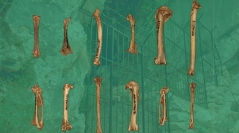

 Comptes Rendus Palevol
20 (30) - Pages 627-640
Comptes Rendus Palevol
20 (30) - Pages 627-640Birds are abundant in fossil assemblages of Quaternary sites; they can be used in landscape reconstruction as they are well adapted to the environment. Here we present the analysis of the avian assemblage from the Middle Paleolithic levels of the Llonin Cave, where 558 bird remains have been recovered from levels G-VI and CP-VIII, belonging to at least ten different taxa: Aves indet., Galliformes indet., Lagopus lagopus Linnaeus, 1758, Tetrastes bonasia Linnaeus, 1758, Columba livia/oenas Gmelin, 1789/Linnaeus, 1758, Passeriformes indet., Alaudidae indet., Motacilla sp., Turdus sp., Corvidae indet., Garrulus glandarius Linnaeus, 1758, Pyrrhocorax sp., Pyrrhocorax pyrrhocorax Linnaeus, 1758, Pyrrhocorax graculus Linnaeus, 1766 and Corvus corax Linnaeus, 1758. This assemblage is similar to other assemblages from the Upper Pleistocene of the north of the Iberian Peninsula, and it reflects a mixed landscape, with open areas and woodland. The taphonomic analysis points to a mixed origin of the accumulation, mainly formed by medium-sized corvids dying in the cave, and also raptors accumulating their prey.
Avifauna, karstic system, Middle Paleolithic, Iberian Peninsula, Lagopus, Tetrastes